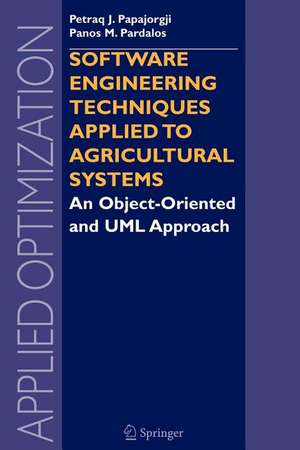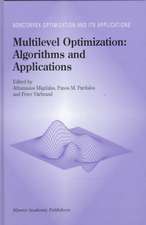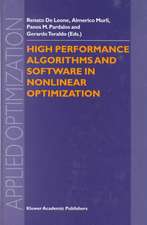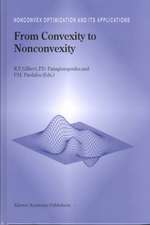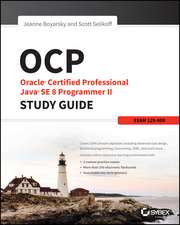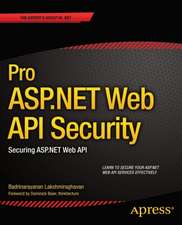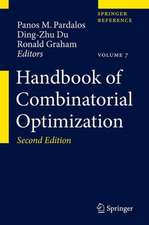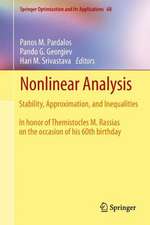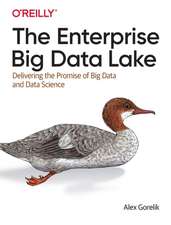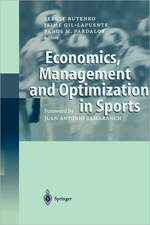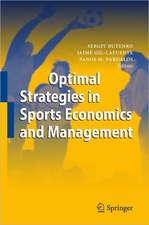Software Engineering Techniques Applied to Agricultural Systems: An Object-Oriented and UML Approach: Applied Optimization, cartea 100
Autor Petraq Papajorgji, Panos M. Pardalosen Limba Engleză Paperback – 23 noi 2010
The book presents a step-by-step approach for modeling agricultural systems, starting with a conceptual diagram representing elements of the system and their relationships. Furthermore, diagrams such as sequential and collaboration diagrams are used to explain the dynamic and static aspects of the software system.
Din seria Applied Optimization
-
 Preț: 127.66 lei
Preț: 127.66 lei - 15%
 Preț: 643.34 lei
Preț: 643.34 lei - 18%
 Preț: 1231.47 lei
Preț: 1231.47 lei - 15%
 Preț: 638.24 lei
Preț: 638.24 lei - 15%
 Preț: 646.62 lei
Preț: 646.62 lei - 18%
 Preț: 1116.89 lei
Preț: 1116.89 lei - 15%
 Preț: 638.76 lei
Preț: 638.76 lei - 15%
 Preț: 643.84 lei
Preț: 643.84 lei - 15%
 Preț: 640.88 lei
Preț: 640.88 lei - 20%
 Preț: 995.09 lei
Preț: 995.09 lei - 15%
 Preț: 650.37 lei
Preț: 650.37 lei - 18%
 Preț: 1233.69 lei
Preț: 1233.69 lei - 18%
 Preț: 954.14 lei
Preț: 954.14 lei - 18%
 Preț: 1240.79 lei
Preț: 1240.79 lei - 18%
 Preț: 1226.24 lei
Preț: 1226.24 lei - 18%
 Preț: 1235.43 lei
Preț: 1235.43 lei - 18%
 Preț: 1221.51 lei
Preț: 1221.51 lei - 18%
 Preț: 1231.32 lei
Preț: 1231.32 lei - 18%
 Preț: 959.36 lei
Preț: 959.36 lei - 15%
 Preț: 600.26 lei
Preț: 600.26 lei - 15%
 Preț: 654.62 lei
Preț: 654.62 lei - 18%
 Preț: 953.35 lei
Preț: 953.35 lei - 18%
 Preț: 949.23 lei
Preț: 949.23 lei - 15%
 Preț: 642.68 lei
Preț: 642.68 lei - 15%
 Preț: 643.34 lei
Preț: 643.34 lei - 15%
 Preț: 641.71 lei
Preț: 641.71 lei
Preț: 979.71 lei
Preț vechi: 1224.65 lei
-20% Nou
Puncte Express: 1470
Preț estimativ în valută:
187.49€ • 203.59$ • 157.49£
187.49€ • 203.59$ • 157.49£
Carte tipărită la comandă
Livrare economică 22 aprilie-06 mai
Preluare comenzi: 021 569.72.76
Specificații
ISBN-13: 9781441939265
ISBN-10: 1441939261
Pagini: 264
Ilustrații: XIV, 248 p. 177 illus.
Dimensiuni: 155 x 235 x 14 mm
Greutate: 0.37 kg
Ediția:2006
Editura: Springer Us
Colecția Springer
Seria Applied Optimization
Locul publicării:New York, NY, United States
ISBN-10: 1441939261
Pagini: 264
Ilustrații: XIV, 248 p. 177 illus.
Dimensiuni: 155 x 235 x 14 mm
Greutate: 0.37 kg
Ediția:2006
Editura: Springer Us
Colecția Springer
Seria Applied Optimization
Locul publicării:New York, NY, United States
Public țintă
ResearchCuprins
Concepts and Notations.- Programming Paradigms.- Basic Principles of the Object-Oriented Paradigm.- Object-Oriented Concepts and Their UML Notation.- Relationships.- Use Cases and Actors.- UML Diagrams.- Design Patterns.- Applications.- The Kraalingen Approach to Crop Simulation.- The Plug and Play Architecture.- Soil Water-Balance and Irrigation-Scheduling Models: A Case Study.- Distributed Models.- Epilogue.
Recenzii
"The book will be useful for those interested in gaining a quick understanding of current software development techniques, and how they are applied in practice... this is a good introductory text on the application of OOAD, UML, and design patters to the cretion of agricultural systems. It is technically sound and well written."
—Raghvinder Sangwan, Computing Reviews, September 2006
—Raghvinder Sangwan, Computing Reviews, September 2006
Textul de pe ultima copertă
Software Engineering Techniques Applied to Agricultural Systems presents cutting-edge software engineering techniques for designing and implementing better agricultural software systems based on the object-oriented paradigm and the Unified Modeling Language (UML). The book is divided in two parts: The first part presents concepts of the object-oriented paradigm and the UML notation of these concepts, and the second part provides a number of examples of applications that use the material presented in the first part. The examples presented illustrate the techniques discussed, focusing on how to construct better models using objects and UML diagrams. More advanced concepts such as distributed systems and examples of how to build these systems are presented in the last chapter of the book.
The book presents a step-by-step approach for modeling agricultural systems, starting with a conceptual diagram representing elements of the system and their relationships. Furthermore, diagrams such as sequential and collaboration diagrams are used to explain the dynamic and static aspects of the software system.
Audience
This book is intended for anyone involved in software development projects in agriculture, including managers, team leaders, developers and modellers of agricultural and environmental systems.
The book presents a step-by-step approach for modeling agricultural systems, starting with a conceptual diagram representing elements of the system and their relationships. Furthermore, diagrams such as sequential and collaboration diagrams are used to explain the dynamic and static aspects of the software system.
Audience
This book is intended for anyone involved in software development projects in agriculture, including managers, team leaders, developers and modellers of agricultural and environmental systems.
Caracteristici
Provides a holistic approach, based on the object-oriented paradigm and the Unified Modelling Language, for designing and implementing software for agricultural and environmental systems Includes supplementary material: sn.pub/extras
